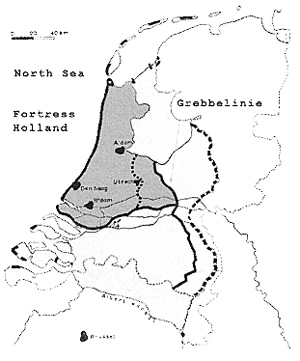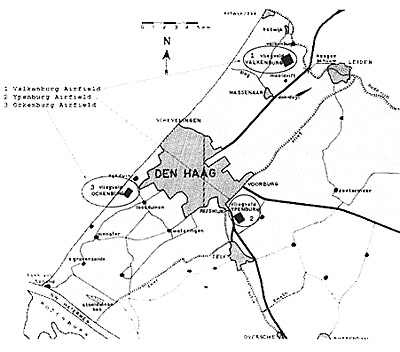Dutch Situation
Both the Dutch government (including Queen Wilhelmina) as well as the Dutch supreme command settled in The Hague. If they could be captured on the first day of the campaign, then the Dutch army would be without any leadership and communications. The capture of the Queen alone would be a huge blow to Dutch morale. It stands to reason that this would lead to nothing but complete victory for the Germans within one day.
The town of The Hague was situated near the Dutch coast. Therefore, it was impossible for German ground forces - no matter how strong - to reach that objective and capture it by surprise. It had to be done in a different way. An evil plan came to mind.
Hitler thought it had to be possible to put down an airborne army of two complete divisions and support in the heart of Holland. Heavily supported by air power-to make up for the lack of artillery-these troops were thought to be able to capture the Crown, government and supreme command. In the process they also had to capture some vital bridges in and around Rotterdam. The success of this operation would make it possible for elements of the 9th Panzer Division to drive straight into the heart of Holland.
The Dutch Army
When the First World War broke out in 1914, the Dutch followed a policy of strict neutrality. That this neutrality was largely respected by all sides was a good thing, because the Dutch army those days was anything but modern.
It was widely believed that the League of Nations raised after World War One would prevent the outbreak of new major wars. Therefore, merely adequate money was made available to the department of defense. Modernization of the army was not possible. Conscription was brought back to 5 and a half months. To make things worse, those who sacrificed a number of free Saturdays could bring conscription back to an astonishing period of one and a half months.
Only when Hitler rose to power in Germany and made clear that his intentions were anything but peaceful did the Dutch Government finally put the Department of Defense up on their priority list. This effort, was, however, too little, too late, especially since half the world was re-arming and the arms industry already wasn't able to meet that demand. The equipment on hand was very modern, but available only in small quantities. For example, only twenty percent of the needed anti-aircraft guns had been delivered when war broke out.
 Map A: Holland and the defensive lines. One can clearly see that the supreme North Sea
command wasn't planning upon defending the whole country. The most important part was fortified and known as "Fortress Holland. " The lines were ineptly prepared and in best case featured concrete pillboxes.
Map A: Holland and the defensive lines. One can clearly see that the supreme North Sea
command wasn't planning upon defending the whole country. The most important part was fortified and known as "Fortress Holland. " The lines were ineptly prepared and in best case featured concrete pillboxes.
The main line of defense was thought to be the Grebbeberg in the center. Right behind was an old line around the city of Utrecht, called Waterline. This line had never been completed. Due to the lack of money and priority, most lines had not been prepared to the full extend, A lot of trees still blocked line of sight in front of Grebbeberg. A lack of money prevented them from being cut down.
Also, the reserve units of the Dutch army (4 divisions) were situated in "Fortress Holland." In the event of war, they had to guard the coast and race to the rescue in the east. No one ever expected these troops to become the frontline force in the first hours of the war.
Upon Dutch mobilization in August 1939, all lines of defense still had to be built. Quite a number of advised improvements weren't implemented, because they were thought to be too expensive. These included "silly" things like clearing of fields of fire just in front of lines of defensive (see map A) ' Since total neutrality had been declared, the army could not focus only on the defenses against Germany. Therefore a coastal defense system also had to be implemented. Furthermore the government refused to proclaim martial law, since it might give off the "wrong" signal. This enabled German officers to inspect Dutch lines of defense right until war broke out.
It was clear to the supreme command that the army would be unable to defend the whole country. Therefore, they created a fortified zone around the major towns and facilities. This was called "Fortress Holland" (see map A). More to the East, another line was created with the sole purpose of winning a little time.
When the Germans finally invaded, the Dutch air force consisted of 124 planes of which most were obsolete. Inall there were 26 light armored cars and only a few anti-tank guns. Ten poorly trained, poorly armed, under-strength divisions had to defend a country that had not even been properly prepared for war. They were backed up by artillery fielding guns dating back to 1878.
The Hague
Around The Hague (See map B), little defensive measures had been taken. Only a handful of (admittedly very modern) anti-aircraft guns guarded the airfields.
 Map B: Map of city of The Hague (Dutch: Den Haag) and surroundings. Notice the three airfields, the north sea in the West, "Hoek van Holland" in the lower left corner and the city of Delft in the middle. just on the edge near Rotterdam you can also see the small village of Overschie. The last one is important as it is located right between the areas of operations of 22nd Airlanding and 7th Flieger.
Map B: Map of city of The Hague (Dutch: Den Haag) and surroundings. Notice the three airfields, the north sea in the West, "Hoek van Holland" in the lower left corner and the city of Delft in the middle. just on the edge near Rotterdam you can also see the small village of Overschie. The last one is important as it is located right between the areas of operations of 22nd Airlanding and 7th Flieger.
The limited German air landings in Denmark and Norway forced the decision to guard the airfields around the clock. A few infantry units armed with machineguns; were based at the airfields. In case of need, badly trained lightly armed depot troops could be requested from reserves.
More May 1940: German Assault on the Hague
-
General Introduction
Dutch Situation and Plans
German Situation and Plans
May 10, 1940: The War Begins
May 11, 1940
May 12, 1940
May 13, 1940
May 14, 1940 and Aftermath
Back to Table of Contents -- Operations #41
Back to Operations List of Issues
Back to MagWeb Master List of Magazines
© Copyright 2001 by The Gamers.
This article appears in MagWeb (Magazine Web) on the Internet World Wide Web.
Other military history articles and gaming articles are available at http://www.magweb.com